1950 Barlevi MILITARY Jewish LITHO CARD GAME Judaica HEBREW Ranks IDF Insignia

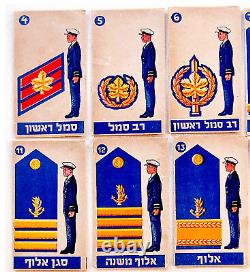
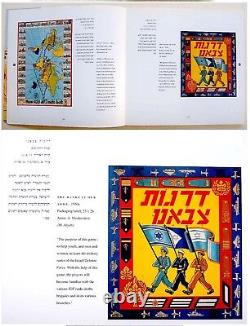
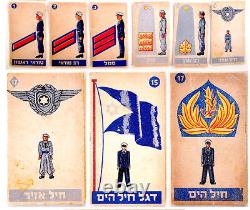
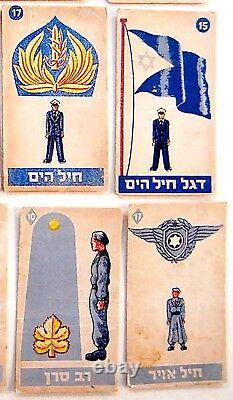
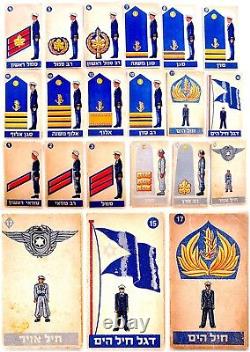
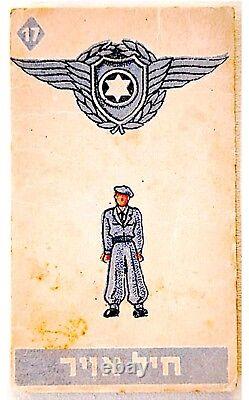
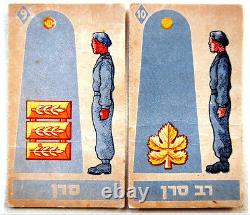
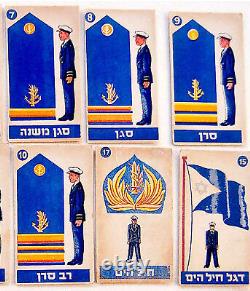
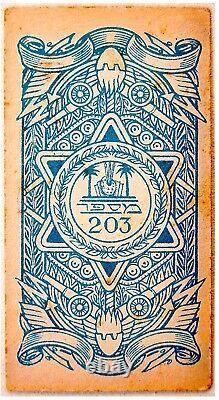
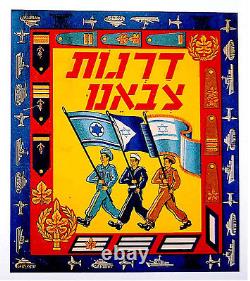
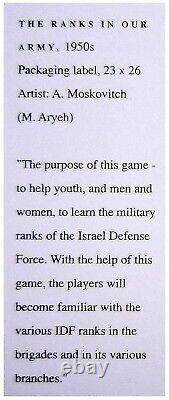


The purpose of this card game was " TO HELP YOUTH and MEN and WOMEN to LEARN the MILITARY RANKS of the ISRAEL DEFENSE FORCE (IDF) ". Included are the RANKS, EMBLEMS, INSIGNIA and TYPICAL UNIFORMS of the AIRFORCE, NAVY and INFANTRY. The CARD GAME was designed , created and published in the early 1950's , Right after the times of the BRITISH MANDATE, One or two years after the STATE of ISRAEL was established and after its 1948 WAR OF INDEPENDENCE.
The Graphic design was made by M. The CREATOR of this BOARD GAME was the legendary ARIEH BARLEVI, The main manufactor of GAMES : Board games and CARD GAMES in Eretz Israel - Palestine and later on in Israel state - This CARD GAME is numbered "203". One of the Barlevi's Eretz Israeli CARD GAMES. This SPECIFIC pack of the CARD GAME may have been published by BARLEVI in the very early 1950's or even the late 1940's.
Never saw the BOXED GAME and the reference which are hereunder pictured doesn't mention how many cards were originaly issued in the complete game. Size around 2.5" x 4".
This PARTIAL PACK consists of 18 cards. The CARDS are used but yet in a VERY GOOD CONDITION. Somewhat worn(Pls look at scan for accurate AS IS images). Will be sent in a special protective rigid sealed package.
REFERENCE : Kindly look for more details about the BARLEVY GAMES at 1999 Exhibition catalogue A TRIP ACROSS The COUNTRY - GAMES From Mr. BARLEVI STORE - Games from the GAME COLLECTION of DAVID TARTAKOVER. Also for sale by Judaica-Bookstore. AUTHENTICITY : This ILLUSTRATED pack of 18 cards game is fully guaranteed ORIGINAL from BARLEVI, Being a 1950's or even earlier edition , It is NOT a reproduction or a recently made reprint or an immitation, It holds a life long GUARANTEE for its AUTHENTICITY and ORIGINALITY. ITEM will be sent in a special protective rigid sealed package.
The Israel Defense Forces (IDF) has a unique rank structure. Because the IDF is an integrated force, ranks are the same in all services there is no differentiation between army, navy, air force, etc. The ranks are derived from those of the paramilitary Haganah developed in the Mandate period to protect the Yishuv. This origin is reflected in the slightly compacted rank structure; for instance, the Chief of Staff (rosh ha'mate ha'klali, or ramatkal) is seemingly only equivalent to a lieutenant general in other militaries. Rav aluf (Ra'al) (Chief of General Staff) (Field Marshal, equivalent to NATO OF-10) (Rav aluf means "chief champion" or "chief thousandman") N/A????
Aluf Commanding general of a branch of arms (ground force, air force or navy) or a regional command. (Lieutenant-General, equivalent to NATO OF-8) (Aluf, meaning "champion" of "thousandman") (Note that in the original IDF ranks of 1948, aluf was intended to loosely translate as colonel)?? Tat aluf (Ta'al) Commanding general of an arm of service (service corps) or division commander (Brigadier-general, equivalent to NATO OF-6) (Tat aluf translates as "subordinate champion" or "sub-thousandman") [Since 1968]?????? Senior officers or Field grade officers????
Aluf mishne (Alam) (Executive officer of a division; brigade commander) (Colonel, equivalent to NATO OF-5) (Aluf mishne translates as "secondary champion" or "secondary thousandman")??? Sgan aluf (Sa'al) (Executive officer of a brigade; battalion commander) (Lieutenant Colonel, equivalent to NATO OF-4) (Sgan aluf translates as "deputy champion" or "deputy thousandman") (Note that in the original IDF ranks of 1948, sgan aluf was intended to loosely translate as lieutenant colonel)?????? Junior officers or Company grade officers??
Rav seren (Rasan) (Battalion executive officer) (Major, equivalent to NATO OF-3) (Rav seren means "chief military commander")??? Seren (Company / battery commander) (Captain, equivalent to NATO OF-2) (Seren, meaning "captain", translates as "captain" or "military commander")???
Segen rishon (Sagar) - [From 1948-51] (Company executive officer; platoon leader) (FIrst Lieutenant, equivalent to NATO OF-1) (Segen rishon means "lieutenant first class"; segen literally translates as "deputy")??? Segen mishne (Sagam) - [Since 1951]??? Segen - [From 1948-51] (Platoon leader) (Second lieutenant, equivalent to NATO OF-1) (Segen mishne, means "second lieutenant"; segen literally translates as "deputy")?????? Katzín akademai bakhír (Ka'ab) Professional officer of the first class in the reserve - equivalent to a brevet captain. Officer of medical service, officer of dental medical service, officer of veterinary service, officer of justice, officer of religion. Katzín miktsoí akademai (Kama) Professional officer of the second class in the reserve - equivalent to a brevet first lieutenant. Rav nagad (Ranag) (Chief warrant officer, most senior specialist professional, equivalent to NATO OR-9) (it translates as "chief warrant officer" or "chief NCO") [Since 1993] [2]?? Rav nagad mishne (Ranam) (Warrant officer, senior specialist professional, equivalent to NATO OR-9) (it translates as "junior chief warrant officer" or "junior chief NCO") [Since 2011]??Rav samal bakhír (Rasab) (Command sergeant major, senior NCO of a Regiment or Brigade, equivalent to NATO OR-9) (it translates as "senior chief sergeant")?? Rav samal mitkadem (Rasam) (Sergeant major, senior NCO of a battalion, equivalent to NATO OR-8) (it translates as "advanced chief sergeant")??
Rav samal rishon (Rasar) (Master sergeant, senior NCO of a company or battery, equivalent to NATO OR-8) (it translates as "chief sergeant first class")?? Rav samal (Rasal) (Sergeant first class, a platoon sergeant, equivalent to NATO OR-7) (it translates as "chief sergeant")?????? Samal rishon (Samar) (Staff sergeant, a squad leader, NATO OR-6) (it translates as "sergeant first class")??? Samal[3] (Sergeant, a team leader, NATO OR-5) it translates as "sergeant". Rav turai (Rabat) (Corporal, a team leader, NATO OR-4) (it translates as "chief private")????? Turai (Private E-2 or private, NATO OR-2) (it translates as "private") (none) Officers (ktzinim): Volunteers who have completed the officer's course.Officers serve for at least 48 months (4 years); pilots have to serve for 7 years. Promotions are based on ability and time served.
It takes about a year to be promoted from 2nd lieutenant to 1st lieutenant and three years to be promoted from 1st lieutenant to captain. Army officers have bronze-metal insignia (replaced with subdued black-metal insignia in 2002), air force officers have silver metal insignia, and navy officers have gold-metal insignia or gold braid bars.
Officers without a university education can be promoted to a maximum of Rav Seren (Major), although the IDF often sponsors the studies for their majors. Academic officers (ktzinim akademaim): Special rank given to soldiers who are delaying completing officers' training so they can complete a professional education (usually in engineering, medicine, or law). A kama is equivalent to a 2nd lieutenant, and a ka'ab is equivalent to a 1st lieutenant, but are treated as if they were breveted to the next higher rank. Officers of these ranks are considered professional manpower and rarely take posts of command.
Upon finally completing officers' training, an academic officer is immediately awarded the corresponding next "real" rank due to their experience in grade. Their insignia bars are embossed with scrolls (megilot) rather than laurel branches (aronot). Non-commissioned officers (nagadim): The professional non-commissioned and warrant ranks, drawn from volunteers who signed on for military service after completing conscription. They usually are assigned to head-up the headquarters staff of a unit.Nagad is a variant of the biblical word nagid, which means ruler or leader. Samal is a Hebrew abbreviation for segen mi-khutz la-minyan, which translates as "supernumerary deputy"; it is a Field NCO rank equivalent to a British or Commonwealth "Sergeant". Rav samal translates as "chief sergeant"; it is a career NCO rank equivalent to a British or Commonwealth "Staff Sergeant" or "Sergeant Major" / "Warrant Officer". Rav nagad is equivalent to the American rank of "Chief Warrant Officer".
Enlisted (hogrim): The conscript and field NCO ranks. All Jewish or Druze conscripts must start their compulsory service at 18 (unless they receive a deferment); Christians, Muslims, and Circassians may volunteer at 17 or older. Enlisted male conscripts serve for 32 months (2 years and 8 months) and female conscripts serve for 24 months (2 years). In the IDF enlisted ranks are earned by means of time in service (pazam), rather than by a particular post or assignment. After 4 to 12 months the conscript is promoted to rav turai, after 18 to 24 months promoted to samal, and after 24 to 32 months is promoted to samal rishon.
(This means that female conscripts can reach no higher than samal during their compulsory service). Field NCOs (samal and samal rishon) who command sub-units (fire team or squad, respectively) are called mashak. This is an abbreviation that translates into English literally as "non-commissioned officer". It is a term of respect like the French Army's chef ("chief"). Recruits (tironim): Upon enlistment to military service in Israel, all soldiers begin a basic training course and undergo several weeks or months of'integration' from citizens to soldiers. This course is called tironut ("recruit training") and the soldier being trained on this course is called a tiron (or "recruit"). This is often erroneously interpreted as a rank, similar to the US Army's private (E-1); tironim are ranked as turai (private), the same rank and paygrade as newly trained conscripts.[4] Both officers and enlisted personnel have an obligation to serve in the Reserves after completing their active military service. Male personnel serve until 41-51 years old while female personnel serve until 24 years old.
Obsolete ranks[edit] Category Rank name, [1] rank equivalent and NATO code Insignia No longer in use???? Memalei makom katzín (Mamak) (Acting officer or aspirant; A brevet officer ranking below a junior lieutenant) (Memale makom translates as "substitute", and katzin means "officer") (Memale makom literally translates as "filling in the place of another") [Existed from the 1960s until 1994]??? Samal bakhír (Samab) (First Sergeant, NATO OR-8; it translates as "Senior Sergeant") Existed from 1948 to 1952 and no longer in use. (See comments in notes in the bottom) A Brass badge (a small oak leaf within a laurel wreath) on 3 half-chevrons?? Rav turái rishón (Ratár) (First corporal, NATO OR-3; it translates as "chief private first class") Existed from 1972 to 1982 and no longer in use.
(See comments in notes in the bottom)????? Turai rishon (Tarash) (Private E-3 or private first class, Nato OR-3) Existed until 1999 and no longer in use. (See comments in notes in the bottom) The rank of memale makom katzín???? Or "substitute officer" was created in the 1960s.
The rank was considered below a 2nd Lieutenant (sagam). It indicated a cadet in the Israeli army who had finished the basic preparation for an officer rank???? , but for some reason abandoned their studies, failed to complete the professional officer preparation????? , or completed it with a minimal passing grade but was still found worthy of command.
They occupied the lowest officer posts until a normal officer rank was found for the position. Those who finished the officer preparation with a minimal passing grade and were substituting in a command position were eligible for promotion to normal officer rank after a set period. It was discontinued in 1994.
The rank of Samal Bakhír ("Senior Sergeant") was used from 1948 to 1952. It was the equivalent of a US Army First Sergeant. It was replaced by the rank of Rav Samal Yekhidati ("Unit Senior Sergeant"), similar to a British or Commonwealth Army Warrant Officer II (Company Sergeant Major). The rank of rav turái rishón or "chief private first class" was used from 1972 to 1982. There was an expansion of staff NCO ranks during this period and the higher rank was offered to conscripts who planned to enlist after completing their national service.
The rank of turai rishon or "private first class" was disestablished in the Regular IDF in 1990. It still continued to be used in the Reserves until it was finally discontinued in 1999. Privates now retain their rank until promoted to corporal, usually after 10 months of peacetime service (6 months for support roles or 4 months for combatants). Corporals in combat units traditionally do not wear their rank insignia, remaining without insignia until they are promoted to the rank of sergeant. Insignia[edit] Aiguillettes, srochim in Hebrew:'[5] Black cord: Instructors at the various Military Schools. Blue cord: Staff at the various Military Schools. Brown cord: A soldier or commanding officer serving as part of the psychological branch. Red cord: Instructor at the Airborne and Naval Training Schools. White cord: Educators and trainers in the Education and Youth Corps. White & blue cords: Mefaked mishma'at ("discipline commander"; soldier in charge of unit discipline who assists the unit NCO-in-charge). When worn by hogrim, it reflects completion of tironut level 2. Blue & red cords: Military police. Diced blue and red cord: Prison service Green cord: Mefaked ("commander"), worn by Hogrim that went through a commanding course, Soldiers that did not go through officers course and that are in mandatory service of three years (for men and women in combatant units) or two years (for women in standard service). It is worn by combat leaders on the fire team (Sergeant), squad (Staff Sergeant), platoon (Lieutenant), company (Captain) and battalion (Major or Lieutenant Colonel) level. Purple cord: Service rights staff. The mashak/mashakeet tash ("service rights [male/female] staff NCO")[6][7] is an NCO whose job it is to help conscripts settle into military life and handle any of their complaints or grievances. A specialized staff NCO who deals with the needs and rights of foreign volunteers is called a mashak/mashakeet aliyah, although they wear either white or green lanyards. [6][8] There is one mashak/mashakeet assigned to each company HQ. Purple & blue cord: Reserves office staff. In charge of coordinating and keeping track of a unit's reserve forces. History[edit] When the IDF was created in 1948, there were 7 enlisted and NCO ranks, and 8 officer ranks. This was due to the average Israeli servicemen's experience in the Commonwealth forces during World War Two. [dubious - discuss] This was later reformed when the IDF started to adopt a rank system similar to the United States armed forces in 1973 and the 1990s.Rank insignia were originally cut from cloth or embroidered onto cloth patches. Bronze-metal officer's rank insignia worn on a red cloth backing were introduced for the army in 1949. Enlisted stripes for all arms were originally individual white half-chevrons with space between them.
In an economy move, senior NCOs were distinguished by using the same bronze insignia (an oak-leaf or oak-leaf-in-a-wreath) as senior officers pinned to their sleeve insignia. In 1951 the Navy adopted golden-yellow half-chevrons and the Air Force adopted blue half chevrons. A samal rishon was equal to a British Army staff sergeant / colour sergeant or a US Army technical sergeant (sergeant first class) / platoon sergeant. For the other services, the bronze-metal oak-leaf on the army's samal rishon rank insignia was replaced with a yellow anchor in a white hexagon for the Navy and a blue Star of David on a white circle for the Air Force.
This was later replaced in 1951 with a gold-metal oak leaf for the Navy and a silver-metal oak leaf for the Air Force. The rank insignia was a small bronze oak leaf in a wreath on 3 white half-chevrons for the Army; a yellow anchor in a yellow-bordered (1948) or solid-yellow (1950) hexagon on 3 white half-chevrons for the Navy; and a blue Star of David in a blue-bordered circle on 3 white half-chevrons for the Air Force.
It was replaced by the reorganized Rav Samal rank in 1951 and the new Rav Samal Yehidati rank by 1955. The rank insignia was an Oak Leaf in a Laurel Wreath. It came in bronze-metal on a red enamel backing for the Army, gold-metal for the Navy, and silver-metal for the Air Force.
It was worn on the lower right sleeve of the shirt or jacket or on a leather wrist strap when wearing short-sleeve order. It was divided into Rav-Samal Miktzoi ("Specialist Chief Sergeant"; a technical NCO) and Rav Samal Yekhidati ("Unit Chief Sergeant"; a command NCO) from 1955 to 1958. The rank insignia was originally an oak leaf in a laurel wreath for the Army, a large yellow anchor in a yellow-bordered (1948) or solid-yellow (1950) hexagon for the Navy, and a large blue Star of David in a bordered circle for the Air Force. The rank was renamed Rav Samal Rishon (1951-Present) and was equivalent to a British Army Warrant Officer I (Regimental Sergeant Major). The new rank also received new insignia made of metal: an Oak Leaf over a vertical Sword in a Laurel Wreath. It was divided into Rav Samal Rishon Miktzoi ("Specialist Chief Sergeant First Class"; a technical NCO) and Rav Samal Rishon Yekhidati ("Unit Chief Sergeant First Class"; a command NCO) from 1955 to 1958. Notes[edit] This section contains embedded lists that may be better presented using prose. You can help by converting the list or lists to prose, if appropriate. (June 2010) (Learn how and when to remove this template message) In the IDF, the same rank titles are used throughout the military, including the Israeli Air Force and Israeli Navy.This contrasts with many other armed forces that have a separate rank system for different branches. [10] Officer insignia are silver with a dark blue background in the Air Force and gold with a black background in the Navy. In the Army, both Lieutenant ranks usually have the blackish-gold ranks (shown above) with an olive-green background, until promoted to the rank of Captain. Enlisted ranks are green in the Army, blue in the Air Force, and golden in the Navy. Subaltern officers (lieutenants and captains) wear rank bars embossed with laurel branches (aronot).
Field and General officers wear "pips" that look like an oak-leaf (alim). As the ranks of the Israel Defense Forces (IDF) are traditionally translated one-to-one to Western ranks then the rank of Aluf???? Is translated as Major General, and Rav Aluf?? Is translated as Lieutenant General. However, a more proper translation (in terms of both language and organizational role) of Aluf would be to full General (OF-9 in NATO terms).
Similarly, as the Hebrew prefix Rav is equivalent to the English prefix arch- (as in archangel), a more fitting translation for the rank of Rav-Aluf would be Arch-General, or, more conventionally, Field Marshal (NATO OF-10). Enlisted rank insignia are worn on the upper arm of the sleeves whereas NCO and officer insignia are worn on the shoulders. This page details the uniforms and insignia of the Israel Defense Forces, excluding rank insignia. For ranks, see Israel Defense Forces ranks and insignia. Contents [hide] 1 Uniforms 2 Berets 3 Beret pins 4 Shoulder tags 4.1 Commands 4.2 Branches 4.3 Corps 5 Insignia 6 References 7 External links 8 Bibliography Uniforms[edit] IDF uniform colors The Israel Defense Forces has several types of uniforms: Service dress (Madei Aleph)[1] - "Class A" uniform; everyday wear, worn by enlisted soldiers.
Field dress (Madei Bet)[2] - "Class B" uniform; worn into combat, training, work on base. Officers / Ceremonial dress (Madei Srad)[3] - Ceremonial uniform; worn by officers, or during special events/ceremonies.
Dress uniform and Mess dress - worn only abroad. There are several dress uniforms depending on the season and the branch. Dress uniforms follow the American model and Mess Dress uniforms follow the British and Commonwealth pattern. The service uniform for all ground forces personnel is olive green; navy and air force uniforms are beige. The uniforms consist of a shirt, trousers, sweater, jacket or blouse, and shoes or boots.
The navy has an all-white dress uniform. Green fatigues are the same for winter and summer and heavy winter gear is issued as needed. Women's dress parallels the men's but a woman may choose to substitute a skirt for the trousers, or sandals for boots. Some corps or units have small variations in their uniforms - for instance, military policemen wear a white belt and white police hat.Similarly, while most IDF soldiers are issued black leather boots, some units issue reddish-brown leather boots for historical reasons- the paratroopers, Nahal and Kfir brigades, as well as some SF units (Sayeret Matkal, Oketz, Duvdevan, Maglan, Counter-Terror School). Additionally, certain special operations units are issued canvas hiking boots for wear during missions. Berets[edit] Soldiers of the Combat Engineering Corps being awarded with Grey berets Each corps in the Israel Defense Forces has a beret of a different color and/or a different beret pin worn by its soldiers, independent of rank and position. Israel Defense Forces soldiers wear berets on their heads only on formal occasions, such as ceremonies and roll calls.
The beret is placed beneath the left shoulder strap while wearing the service uniform (alef), but not while wearing the combat/work (bet) uniform in the field. On base it is left to the unit's discretion whether to wear berets or field hats. Air force and navy officers, military orchestra soldiers and military police law enforcement soldiers wear combination caps.
Formerly, male soldiers of all ranks wore combination caps, while female soldiers wore the garrison cap. In the 1950s, the beret was adopted as the default headgear for the service uniform. The color of the air force beret was blue-gray; armored corps, artillery, and special operations personnel wore a black beret.Paratroopers, following the pattern of the British Army, wore maroon, all other infantry wore olive drab. Combat engineers wore a gray beret.
For all other army personnel, except combat units, the beret for men was green and for women, black. Women in the navy wore a black beret with gold insignia while men wore the traditional white sailor cap like that of the US Navy. IDF soldier from the Golani Brigade, in service dress a S.
C, medic, with the 2006 Lebanon war ribbon & citation Corps Color Air Force Air Force Infantry Corps Golani Brigade Paratroopers Brigade and SF units Nahal Brigade Givati Brigade Kfir Brigade Armor Corps Armor Corps Artillery Corps Artillery Corps Combat Intelligence Corps Combat Intelligence Corps Engineering Corps Engineering Corps Intelligence Directorate of Military Intelligence Military Police Military Police Border Police Border Police Home Front Home Front Command General General Corps Navy Sea Corps Beret pins[edit] All berets in the Israel Defense Forces, other than general corps berets (when worn by recruits), have pins attached to their front, which represent the symbol of the corps. While soldiers may wear the beret of another corps due to serving at that corps' base, they will always wear the pin of their native corps. Each pin consists of the corps symbol as well as a certain ornament which also contains the name of the corps.
Soldiers serving a term in military prison must wear a blank beret with no pins attached. Corps Pin symbol The Chief of Staff Rosh HaMate HaKlali (Ramatkal) Israel Defense Forces Emblem General Staff HaMate HaKlali Sword wrapped by an olive branch Home Front Command Pikud HaOref (Heil HaOref) Sword wrapped by an olive branch with large triangle in the background Military Rabbinate HaRabanut HaTzva'it Figure of the Ten Commandments with a sword in the foreground Military Advocate General HaPraklitut HaTzva'it Scales and a sword Air Force Heil HaAvir Sword, olive branch, Star of David and wings (eagle wings, found at Bet-Shean excavations). Infantry Corps Heil HaRaglim Sword wrapped by an olive branch Armor Corps Heil HaShiryon Tank with olive branches Artillery Corps Heil HaTothanim Cannon/artillery piece Combat Engineering Corps Heil HaHandasa HaKravit Sword and castle surrounded by blast's halo Field Intelligence Corps Heil Ha'Isuf Ha'Kravi Ordnance Corps Heil HaHimush Sword, torch and a cog Medical Corps Heil HaRefu'a Snake around torch with Star of David on the bowl of the torch Intelligence Corps Heil HaModi'in Fleur-de-lis with half a star. C4I Corps Heil HaTikshuv Sword with wings and a pair of lightning bolts Education and Youth Corps Heil HaHinukh VeHaNo'ar Star of David, book and bow and arrow Adjutant Corps Heil HaShalishut Sword wrapped by an olive branch, a book, and a disk Logistics Corps Heil HaLogistika Sword, olive branch and a steering wheel Military Police Heil HaMishtara HaTzva'it Shield and flame Border Police Mishmar HaGvul (Magav) Israel Police Star of David General Corps HaHayil HaKlali Two crossed swords and a fig leaf Navy Heil HaYam Sword wrapped by an olive branch, anchor and seaweed This list is incomplete; you can help by expanding it.
Shoulder tags[edit] Typically, each IDF unit (yehida) has its own shoulder tag (tagei katef). [4] Shoulder tags consist of a long section and a tip, which can be one of four shapes: a circle (commands, directorates and air force units except anti-aircraft), a square (Golani Brigade), a diamond, or a shield-like shape (most common).
Shoulder tags are only worn on dress uniforms, on the left shoulder attached to the shoulder strap. Some of the IDF shoulder tags: Commands[edit] Branches[edit] Corps[edit] Insignia[edit] Aiguillettes, srochim in Hebrew:'[5] Black: Instructors at the various Military Schools. Blue: Staff at the various Military Schools. Red: Instructor at the Airborne Training School. White: Educators and trainers in the Education and Youth Corps. White & Blue: Mefaked Mishma'at ("Discipline commander"; soldier in charge of unit discipline who assists the unit NCO-in-charge). When worn by Hogrim, it reflects completion of Tironut level 02.Blue & Red Cords: Military Police. Diced Blue and Red Cord: Prison Service.
Green: Mefaked (unit or sub-unit commanders). Worn by squad leaders and platoon, company, and battalion commanders to indicate that they have a combat command.
When worn by Hogrim, it reflects completion of Tironut level 03. The mashakeet tash ("Service Rights [Female] Staff NCO")[6][7] is a female NCO whose job it is to help conscripts settle into military life and handle any of their complaints or grievances. A specialized female staff NCO who deals with the needs and rights of foreign volunteers is called a mashakeet aliyah, although mashakiot aliyah wear either white or green lanyards. [6][8] There is one NCO assigned to each company HQ. Purple & Blue: Reserves Office Staff. (born 1944) is an Israeli graphic designer, political activist, artist and design educator. He studied at the Bezalel Academy of Arts and Design, Jerusalem, and is a graduate of the London College of Printing. Since 1975, he has operated his own studio in Tel Aviv, specializing in various aspects of visual communications, with particular emphasis on culture and politics. From 1976, Tatakover has been a senior lecturer in the Visual Communication Department of the Bezalel Academy, is a member of Alliance Graphique Internationale (AGI), has been a president of the Graphic Designers Association of Israel (GDAI). He has established a reputation for a series of politically provocative self-produced posters, some at the time of Rosh Hashanah (the Jewish new year).His compositions are driven more by content or themes than by high aesthetics. He has described his work as a "seismograph" and a way of reacting to events... To alter opinions and attitudes. [1] Tartakover designed Peace Now's logo in 1978.
[2] The logo emerged from a poster created by Tartakover for a mass rally, held in what is now Rabin Square in Tel Aviv on April 1, 1978, titled Peace Now. [2] It became the name of the organization, the first political bumper sticker in Israel[3][4] and it is still one of Israel's most popular stickers. [2] Tartakover, commenting in 2006, said The movement activists liked the logo, [b]ut they thought there should also be a symbol. I told them it wasn't needed - this is the symbol. It took time until they understood that this was the first political sticker in Israel.
"[2] The logo combines two typefaces, "Shalom" (peace) in black traditional Koren Bible Type (designed by Eliyahu Koren) and "Achshav (now) in the red headline-style Haim Type (designed by Yaakov Haim Levitt). He describes himself as "a local designer, " meaning that the subjects he tackles concern Israel.He follows the mantra of Hebrew expressionist poet Avigdor Hameiri b. Andor Feuerstein: "Freedom of opinion is not a right but a duty".
Influences on Tartakover's work stem from Gustav Klutsis, John Heartfield, Alexander Rodchenko, Ben Shahn, and Andy Warhol. He claims that his mentor has been comic-book artist Bob Gill and that best work is the Hebrew-lettered "Peace Now" logo. One-Person Exhibitions Tokyo Designers Space Open Gallery (1982); "Produce of Israel" (1984), Israel Museum, Jerusalem; "Produce of Israel" (1985), Tel Aviv Museum of Art; "Proclamation of the Independence" (1988), Israel Museum, Jerusalem; Espace Floréal, Paris, France (1994); Festival d'affiches, Chaumont, France (1995); Plakatmuseum an Niederrheim, Germany (1997); Passage de Retz, Paris, France (1998); DDD Gallery, Osaka, Japan (1998); Arc en Rêve, Centre d'architecture, Bordeaux, France (1998), Les Rencontres d'Arles festival, France, 2005. Awards In 2002, Tartakover was awarded the Israel Prize, for design. [5][6][7] The judges said, His unique work creates a synthesis between popular and high culture, between the written text and visual imagery, and between personal statements and collective representations of local cultural values.
As a creator, teacher, and an active member of the community for over thirty years, he has influenced the language of visual representation in Israel. [8][5] His work has won numerous awards and prizes and is included in the collections of museums in Europe, U. Prizes include the Gold medal, 8th Poster Biennale (1989), Lahti, Finland; second prize at the Salon of Photography (1990), Kalish, Poland; honourable mention, Helsinki International Poster Biennale (1997); bronze medal, 17th International Poster Biennale (2000), Warsaw; second prize, 13th International Poster Biennale (2001), Lahti, Finland ebay3858. This item is in the category "Collectibles\Religion & Spirituality\Judaism\Images". The seller is "judaica-bookstore" and is located in this country: IL.
This item can be shipped worldwide.- Country of Manufacture: Israel
- Country/Region of Manufacture: Israel
- Religion: Judaism


